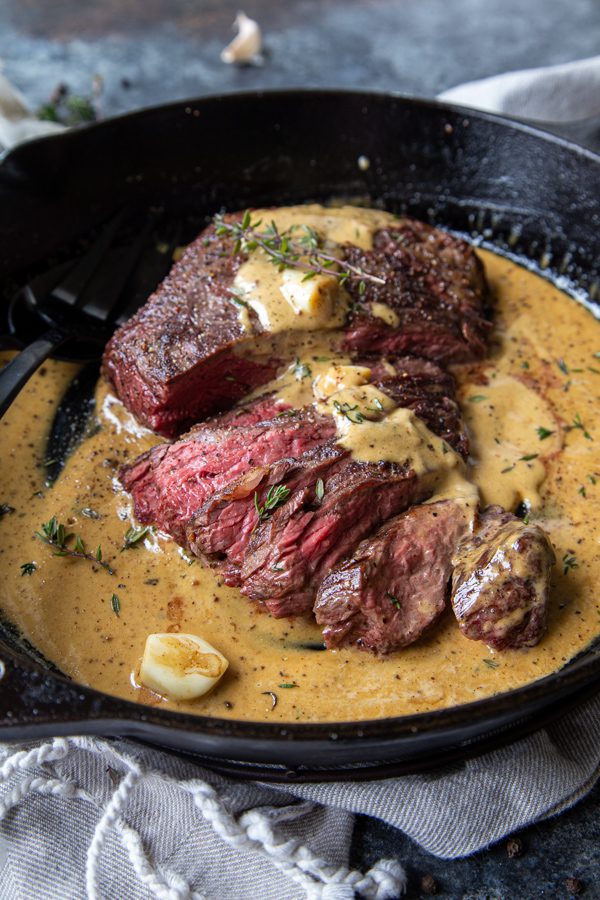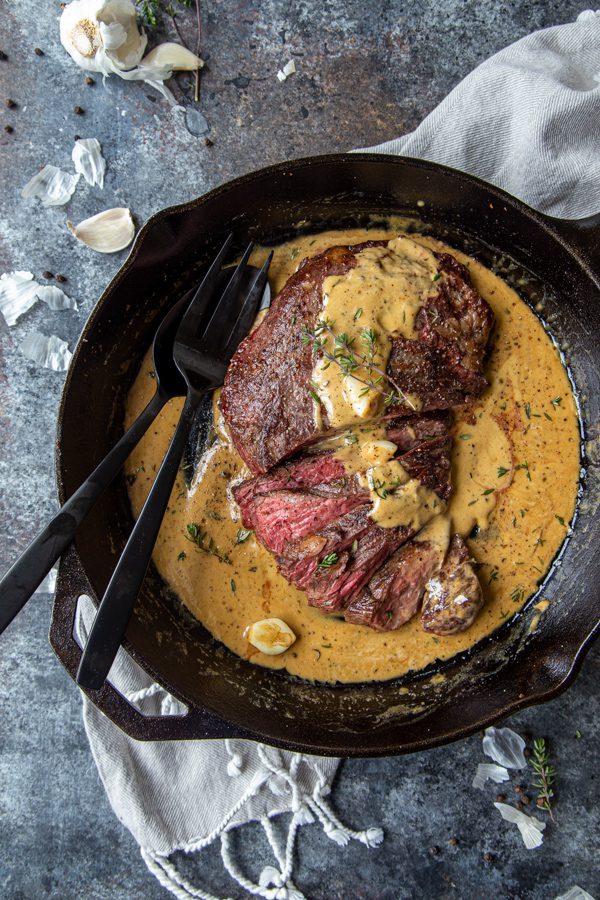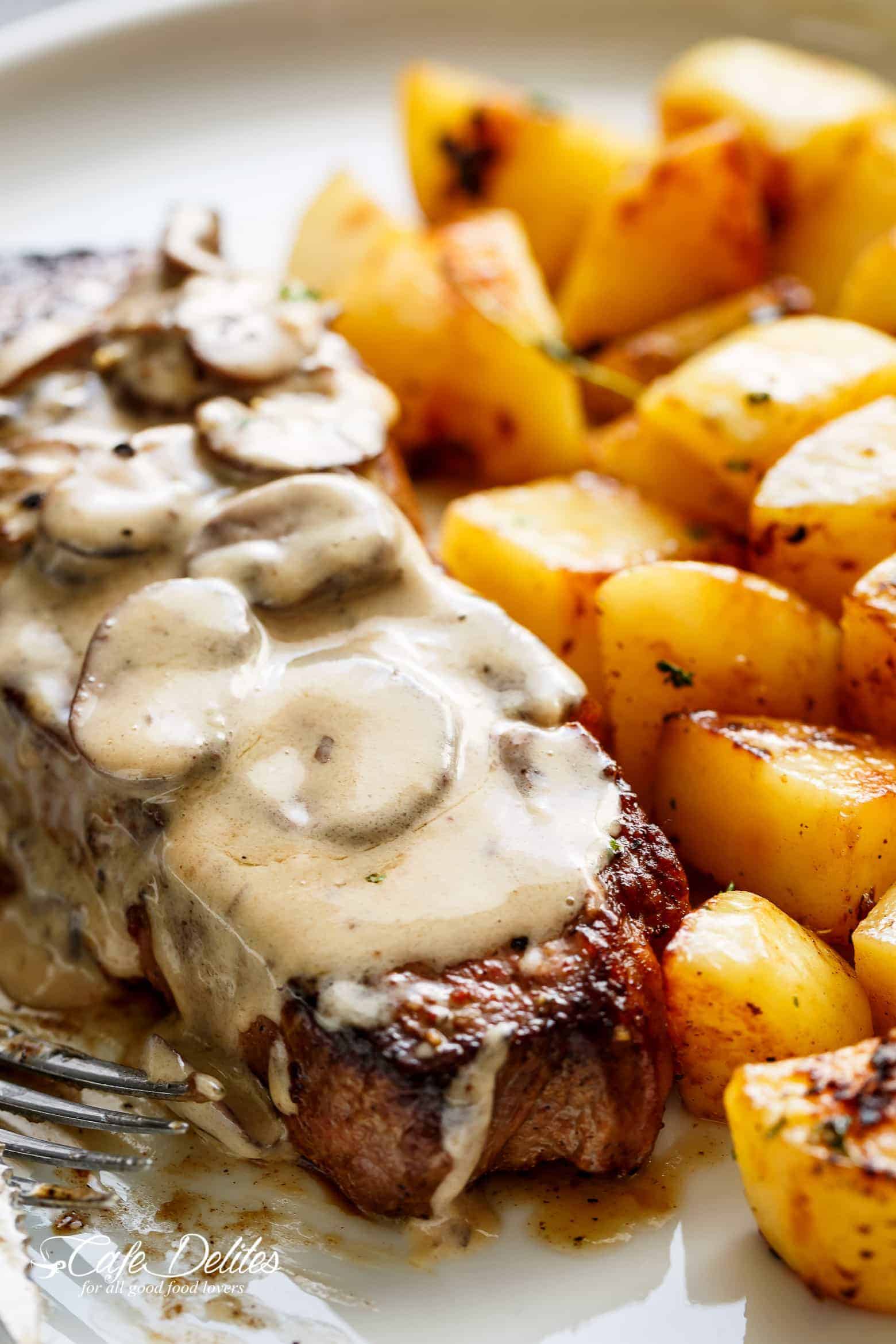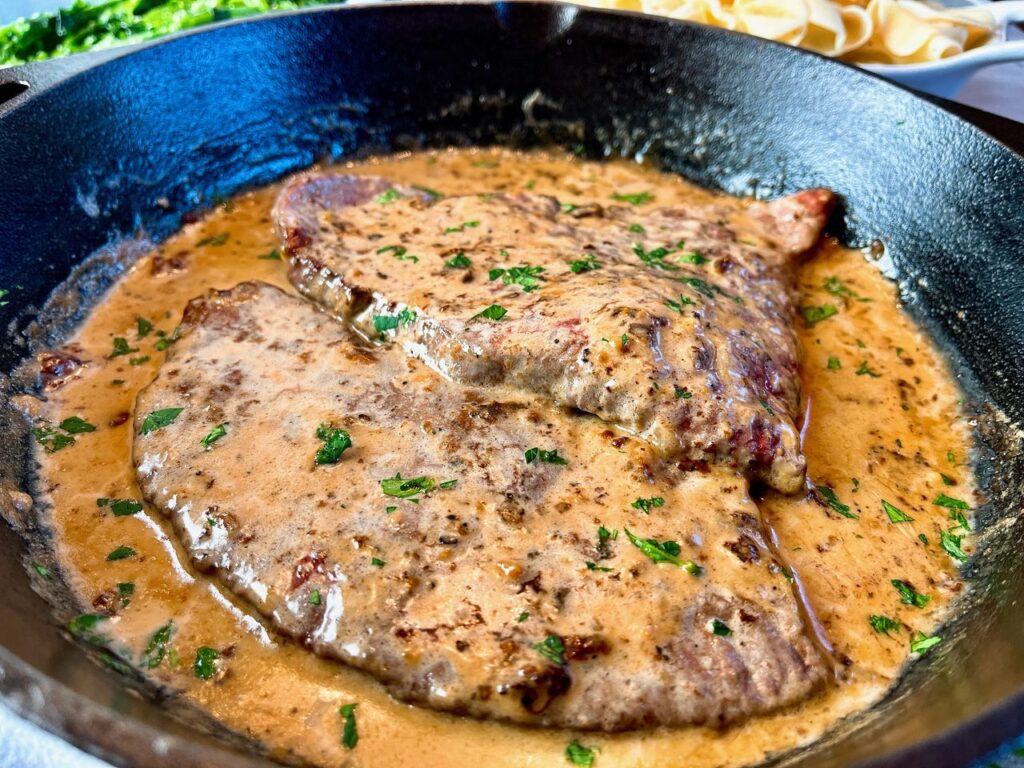Steak with Garlic Cream Sauce is a delicious recipe that combines amazing flavors and textures.
The Art of Perfect Steak with Garlic Cream Sauce
This exquisite Steak with Garlic Cream Sauce represents the pinnacle of culinary sophistication, combining the robust flavor of perfectly cooked steak with an indulgent, velvety garlic sauce. The dish showcases how simple ingredients can transform into an extraordinary dining experience when prepared with technique and care. The garlic cream sauce, with its rich complexity, complements the natural umami of the steak without overpowering it, creating a harmonious balance that delights the palate.
What makes this recipe exceptional is its attention to the scientific principles of cooking. Bringing the steak to room temperature ensures even cooking, while the high-heat sear creates the Maillard reaction that develops hundreds of flavor compounds. The resting period allows muscle fibers to reabsorb juices, resulting in exceptionally tender meat. The sauce builds upon the fond (caramelized bits left in the pan), incorporating these concentrated flavors into a luxurious emulsion.
Historical Context of Steak Preparation
Steak has been a centerpiece of culinary traditions across cultures for centuries. The concept of serving steak with sauce dates back to French culinary arts of the 17th century, where sauces were considered the height of refinement. Escoffier’s classification of mother sauces included béchamel, which forms the foundation of our garlic cream sauce adaptation. This recipe represents a modern interpretation that respects classical techniques while incorporating contemporary flavor preferences.

The garlic cream sauce specifically draws inspiration from French cuisine’s sauce suprême and American steakhouse traditions. The addition of Parmesan cheese introduces an Italian influence, demonstrating how culinary boundaries have blurred in modern gastronomy. This fusion approach creates a sauce with greater complexity and depth than traditional cream sauces, while maintaining the elegance expected of a fine dining experience.
Selecting the Perfect Cut
Ribeye: Known for its marbling, the ribeye offers exceptional flavor and tenderness. The intramuscular fat melts during cooking, basting the steak from within. Choose steaks with even marbling and a bright red color. For this recipe, bone-in ribeye provides even more flavor, though it may require slightly longer cooking time.
Sirloin: A leaner option that still delivers excellent beef flavor. Look for top sirloin with a firm texture and minimal connective tissue. While less marbled than ribeye, proper cooking technique ensures tenderness. Sirloin benefits particularly from the richness of the cream sauce.

Filet Mignon: For ultimate tenderness, filet mignon represents the luxury option. Though less flavorful than other cuts, its buttery texture pairs beautifully with the robust garlic sauce. Consider wrapping filet in bacon to add fat and flavor if using this cut.
Strip Steak: A balanced option with good marbling and beefy flavor. Strip steaks typically have a defined texture that holds up well to rich sauces. Look for steaks with even thickness for consistent cooking.
The Science of Searing
Proper searing requires understanding the physics of heat transfer. When steak hits a hot surface, moisture rapidly evaporates, allowing the surface temperature to exceed 300°F. This creates the Maillard reaction, where amino acids and reducing sugars form hundreds of new flavor compounds. The reaction occurs most efficiently at temperatures between 280-330°F, emphasizing the importance of proper pan temperature.

Contrary to popular belief, searing does not “seal in juices” – in fact, it causes some moisture loss. However, the flavor development far outweighs this minimal juice loss. The crust formation provides textural contrast to the tender interior, while the browning creates complex flavors that form the foundation of the sauce.
Garlic Chemistry and Preparation
Garlic contains alliin and alliinase enzymes that remain separated until crushing or mincing. When combined, they form allicin, which provides garlic’s characteristic pungency. The flavor profile changes dramatically with cooking time and temperature:
Raw Garlic: Sharp, pungent, and spicy due to maximum allicin content.

Sautéed (1-2 minutes): Mellow flavor with slight pungency, optimal for sauces.
Simmered (3+ minutes): Sweet, nutty flavor as allicin breaks down into milder compounds.
For this recipe, we sauté briefly to retain some character while mellowing the harshness. The minced surface area allows for efficient flavor extraction into the fat-based sauce.
Sauce Emulsion Science
The garlic cream sauce represents a fat-in-water emulsion stabilized by dairy proteins and emulsifiers in mustard and cheese. The process begins with creating a stable base:
Fat Content: The butter and heavy cream provide the fat phase, while broth provides the water phase. The ratio must balance richness with proper emulsion stability.
Emulsifiers: Parmesan cheese contains casein proteins that act as emulsifiers, while mustard contains mucilage that stabilizes the mixture. These prevent the sauce from breaking (separating into fat and water phases).
Temperature Control: Maintaining moderate heat prevents the proteins from coagulating too rapidly, which would cause graininess. Gentle simmering allows gradual hydration and stabilization.
Wine Pairing Recommendations
Bold Red Wines: Cabernet Sauvignon’s tannins cut through the richness of the steak and sauce, while its dark fruit notes complement the beef’s umami. Choose a Napa Valley Cabernet for optimal pairing.
Medium-Bodied Reds: Syrah/Shiraz offers peppery notes that harmonize with the garlic, while its acidity balances the creaminess. Australian Shiraz particularly complements this dish.
White Wine Option: For those preferring white, an oaked Chardonnay stands up to the robust flavors. The buttery notes mirror the sauce, while acidity provides balance.
Non-Alcoholic Pairing: Sparkling water with lemon cleanses the palate between bites, while a mushroom-based broth provides umami that complements the dish without alcohol.
Technical Cooking Considerations
Thermometer Accuracy: Use a digital instant-read thermometer for precise doneness control. Test in the thickest part of the steak, avoiding bone or fat. Calibrate regularly for accuracy.
Pan Selection: Cast iron provides superior heat retention for consistent searing. Stainless steel offers responsive temperature control. Avoid non-stick coatings for proper fond development.
Resting Time: The 10-minute rest allows collagen to gelatinize and juices to redistribute. For thicker steaks (over 1.5 inches), extend resting to 15 minutes. The internal temperature will rise 5-10°F during resting.
Modern Variations
Herb-Infused: Add fresh rosemary or thyme to the sauce during simmering for aromatic complexity. Remove before serving for elegant presentation.
Mushroom Enhancement: Sauté sliced cremini mushrooms after cooking steak, then proceed with sauce recipe. The mushrooms add earthy depth and textural interest.
Spicy Version: Incorporate 1 tsp crushed red pepper flakes with the garlic for a subtle heat that cuts through the richness.
White Wine Reduction: Substitute ½ cup dry white wine for half the broth, reducing by half before adding cream. This adds acidity and complexity.
Nutritional Considerations
While indulgent, this dish can be modified for various dietary needs:
Lower Fat: Substitute half-and-half for heavy cream and reduce butter by 25%. The sauce will be less rich but still flavorful.
Dairy-Free: Use coconut cream and nutritional yeast instead of dairy components. The flavor profile will change but remain delicious.
Gluten-Free: The recipe is naturally gluten-free when using certified gluten-free broth and mustard.
Protein Alternatives: Portobello mushrooms or cauliflower steaks make excellent vegetarian alternatives. Adjust cooking times accordingly.
Presentation Techniques
Elevate your plating with these professional techniques:
Sauce Pooling: Create a pool of sauce slightly offset on the plate, arranging sliced steak artfully across it.
Herb Garnish: Use microgreens or herb flowers for elegant color contrast against the rich sauce.
Vegetable Arrangement: Place seasonal vegetables in small groupings around the steak rather than piled together.
Sauce Dots: Using a squeeze bottle, create decorative dots of reduced balsamic glaze around the plate rim for visual interest.
Historical Cooking Methods Comparison
This modern technique contrasts with historical approaches to steak preparation:
19th Century: Steaks were typically pan-fried in lard or drippings and served with simple pan sauces deglazed with wine or vinegar.
Early 20th Century: The invention of commercial refrigeration allowed for dry-aging, transforming steak quality and flavor profiles.
Mid-20th Century: American steakhouse culture emerged, emphasizing thick cuts, high heat, and compound butters rather than cream sauces.
Contemporary: Modern techniques like sous vide followed by searing offer precision, while sauce innovations incorporate global influences.
Cultural Significance
Steak holds cultural significance across various societies:
American Tradition: Steak represents celebration, success, and luxury in American culture, often served for special occasions.
Argentinian Influence: The asado tradition emphasizes pure beef flavor with minimal sauce, contrasting with this recipe’s sauced approach.
French Refinement: French cuisine’s sauce expertise elevates the humble steak to haute cuisine status.
Japanese Precision: Japanese teppanyaki demonstrates how technical precision can transform steak preparation.
Conclusion
This Steak with Garlic Cream Sauce recipe represents the evolution of culinary arts, combining scientific understanding with cultural influences to create an exceptional dining experience. The careful attention to each technical detail – from selecting the proper cut to mastering the emulsion – results in a dish that transcends the sum of its parts. Whether preparing for a special occasion or elevating a weeknight dinner, this recipe offers both impressive results and valuable cooking lessons that apply across culinary endeavors.

Steak with Garlic Cream Sauce
Ingredients
Method
- Remove steaks from refrigerator 30 minutes before cooking to bring to room temperature
- Pat steaks dry with paper towels and season generously with salt, pepper, and paprika on both sides
- Heat olive oil in a large cast-iron skillet over medium-high heat until shimmering
- Add steaks and cook for 4-5 minutes without moving until a golden-brown crust forms
- Flip steaks and add 2 tbsp butter to the skillet
- Continue cooking for another 4-5 minutes for medium-rare (135°F internal temperature)
- For more well-done steaks, reduce heat and cook longer to desired doneness
- Transfer steaks to a cutting board, tent with foil, and let rest for 10 minutes
- In the same skillet, reduce heat to medium and add 4 tbsp butter
- Add minced garlic and sauté for 1 minute until fragrant but not browned
- Pour in beef broth to deglaze the pan, scraping up all the browned bits
- Add heavy cream and Dijon mustard, whisking to combine
- Simmer for 3-4 minutes until sauce begins to thicken
- Stir in Parmesan cheese until melted and smooth
- Add chopped parsley and season with salt and pepper to taste
- If sauce is too thick, add more broth or cream until desired consistency is reached
- Slice steaks against the grain into ½-inch thick slices
- Arrange steak slices on serving plates
- Spoon generous amount of garlic cream sauce over the steak
- Garnish with fresh thyme, red pepper flakes, and additional parsley
- Serve immediately with mashed potatoes, roasted vegetables, or crusty bread



